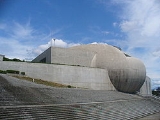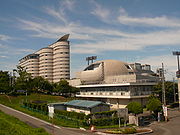
Nagaragawa Convention Center
Encyclopedia
The is a multi-purpose convention center in the city of Gifu
, Gifu Prefecture
, Japan
. The name literally translates to Nagara River International Convention Center, but the official English translation drops "international."
Along with the Gifu Memorial Center
, the Nagaragawa Sports Plaza and Mirai Hall, it is part of the World Event and Convention Complex Gifu.
designed the structure, giving it a unique, egg-shaped look from the outside, making it immediately recognizable.
It opened on September 1, 1995, and is managed by the city's Public Hall Management Group.
 The main hall of the convention center is the largest in all of Gifu Prefecture. It is mainly used for concerts and as a central location for conventions. With an area near 1206 square metre, it seats 1,689 people, but the floors and walls are adjustable, offering many difference configurations. It was named one of Japan's Top 100 Venues for musical performances.
The main hall of the convention center is the largest in all of Gifu Prefecture. It is mainly used for concerts and as a central location for conventions. With an area near 1206 square metre, it seats 1,689 people, but the floors and walls are adjustable, offering many difference configurations. It was named one of Japan's Top 100 Venues for musical performances.
There is also an international conference room located in the dome portion of the egg-like structure. A portion of the wall can open up to a view of the Nagara River
, Mount Kinka
and Gifu Castle
. The room is suitable for mid-sized international conventions and can provide simultaneous interpretations in six languages. There are also small, medium and large meeting rooms available for more private meetings.
The total floor space for the main hall and the eight other rooms is 2332 square metre, allowing seating for over 2,400 people.
provides public transportation from both JR Gifu Station
and Meitetsu Gifu Station
downtown. Riders can get off at either the "Nagaragawa Kokusai Kaigijō Kitaguchi" or the "Nagaragawa Kokusai Kaigijō-mae" bus stop.
Gifu, Gifu
is a city located in the south-central portion of Gifu Prefecture, Japan, and serves as the prefectural capital. The city has played an important role in Japan's history because of its location in the middle of the country. During the Sengoku period, various warlords, including Oda Nobunaga, used...
, Gifu Prefecture
Gifu Prefecture
is a prefecture located in the Chūbu region of central Japan. Its capital is the city of Gifu.Located in the center of Japan, it has long played an important part as the crossroads of Japan, connecting the east to the west through such routes as the Nakasendō...
, Japan
Japan
Japan is an island nation in East Asia. Located in the Pacific Ocean, it lies to the east of the Sea of Japan, China, North Korea, South Korea and Russia, stretching from the Sea of Okhotsk in the north to the East China Sea and Taiwan in the south...
. The name literally translates to Nagara River International Convention Center, but the official English translation drops "international."
Along with the Gifu Memorial Center
Gifu Memorial Center
The is a collection of sports facilities located in Gifu, Gifu Prefecture, Japan. It is a prefectural facility and its purpose is to promote sports and other events within the prefecture....
, the Nagaragawa Sports Plaza and Mirai Hall, it is part of the World Event and Convention Complex Gifu.
Construction
The convention center was built to promote Gifu as a good location for large conventions and has many enticements to attract both domestic and international groups to hold events in the city. The famed architect Tadao AndoTadao Ando
is a Japanese architect whose approach to architecture was once categorized by Francesco Dal Co as critical regionalism. Ando has led a storied life, working as a truck driver and boxer prior to settling on the profession of architecture, despite never having taken formal training in the field...
designed the structure, giving it a unique, egg-shaped look from the outside, making it immediately recognizable.
It opened on September 1, 1995, and is managed by the city's Public Hall Management Group.
Facilities

There is also an international conference room located in the dome portion of the egg-like structure. A portion of the wall can open up to a view of the Nagara River
Nagara River
The has its source in the city of Gujō, Gifu Prefecture, and its mouth in the city of Kuwana, Mie Prefecture, Japan. Along with the Kiso River and Ibi River, the Nagara River is one of the Kiso Three Rivers of the Nōbi Plain. Previously, the river was named Sunomata River . With a length of , it...
, Mount Kinka
Mount Kinka (Gifu)
, also known as Kinkazan, is located in the heart of the city of Gifu, Gifu Prefecture, Japan, and rises to a height of . Previously called Mt. Inaba , it has long served as the representative symbol of Gifu. It stands along the Nagara River, creating bountiful nature within the city...
and Gifu Castle
Gifu Castle
is a castle located in the city of Gifu, Gifu Prefecture, Japan. Along with Mount Kinka and the Nagara River, it is one of the main symbols of the city.-History:Gifu Castle was first built by the Nikaidō clan between 1201 and 1204 during the Kamakura Period....
. The room is suitable for mid-sized international conventions and can provide simultaneous interpretations in six languages. There are also small, medium and large meeting rooms available for more private meetings.
The total floor space for the main hall and the eight other rooms is 2332 square metre, allowing seating for over 2,400 people.
Access
Gifu BusGifu Bus
is a public transportation company based in Gifu, Gifu Prefecture, Japan. It is a subsidiary of Nagoya Railroad and primarily operates within Gifu Prefecture. Some of its public transportation routes within the city of Gifu were handed over by Meitetsu Bus on October 1, 2004. On April 1, 2005, it...
provides public transportation from both JR Gifu Station
Gifu Station
is a train station operated by Central Japan Railway Company and is located in the heart of Gifu, Gifu Prefecture, Japan. Along with Meitetsu Gifu Station, it is one of the two main rail stations in Gifu City.-History:...
and Meitetsu Gifu Station
Meitetsu Gifu Station
is the main terminal of Nagoya Railroad in the city of Gifu, Gifu Prefecture, Japan. It is one of the two major train stations of the city along with JR Gifu Station....
downtown. Riders can get off at either the "Nagaragawa Kokusai Kaigijō Kitaguchi" or the "Nagaragawa Kokusai Kaigijō-mae" bus stop.

